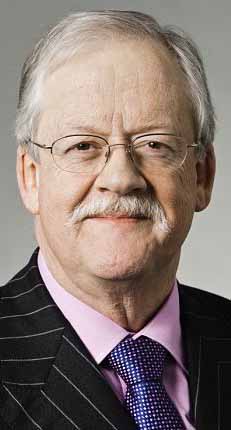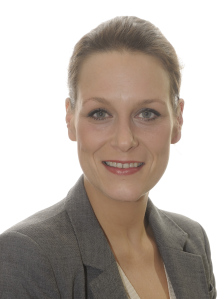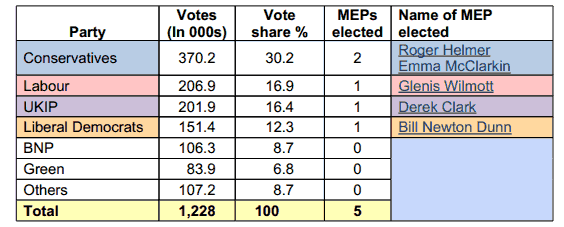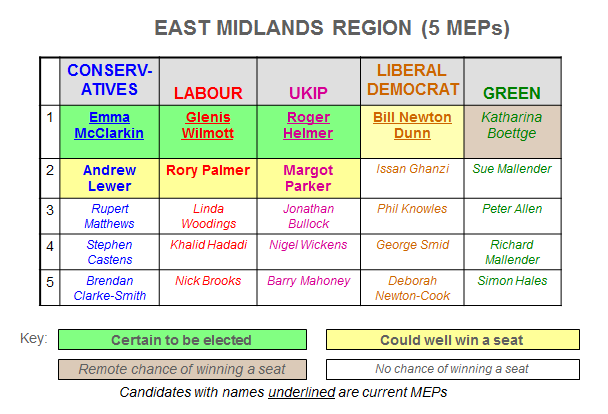Euro Elections – previewing the contest in the East Midlands
Continuing our series on how the European Parliament election will play out at regional level on May 22nd, the Democratic Audit team consider the East Midlands, which will elect five MEPs on polling day. Voters in the region will face interesting choices with the Conservatives, Labour and UKIP all competing strongly to win two MEPs each (only two of whom can succeed), while the Liberal Democrats will struggle to retain their existing long-standing seat.
The East Midlands is a ‘swing’ region, with large urban cities like Nottingham, Leicester, and Derby balanced by their more rural hinterlands and country areas such as Rutland and Louth. In Westminster politics the Conservatives won 12 seats from Labour in the 2010 general election, finishing with 41% of the vote in the region. By contrast, at the previous three elections, Labour won more seats in the region. There are thus numerous marginal seats up for grabs at next year’s general election.
What happened last time, in 2009?
The Conservatives have finished first in this region in all three of the European elections since 1999 held under the current list PR system, although their vote has varied. In 2004 UKIP performed extremely well here, possibly owing to the presence of Robert Kilroy-Silk as their top of the list candidate, with his celebrity attracting a lot of media attention. However UKIP’s vote declined from that peak in 2009, and they finished only third behind Labour, despite the latter’s nationally poor showing. The Liberal Democrats vote has previously hovered steadily around 12%, meaning that even though the region has just 5 MEPs they have secured a seat.
As our first table shows, the Conservatives finished first in 2009, returning two MEPs, while Labour and UKIP almost tied in second and third slots, and the Liberal Democrats finished a clear fourth respectively. The relatively even fragmentation of these votes meant that each of the other parties gains a single MEP. The British National Party (BNP) ran strongly here, nearly reaching 9 per cent support in 2009, while the Greens came in sixth.
Since the election, Roger Helmer MEP, elected as a Conservative, has defected to UKIP, meaning that the Conservatives currently have one incumbent MEP in the region, and UKIP two.
Table 1: What happened last time, June 2009
Note: Our vote data are rounded to the nearest thousand votes. Exact 2009 results are available from UK Polling Report here. Four of the incumbent MEPs are seeking re-election, the exception being Derek Clark from UKIP, who has stood down. However, Roger Helmer is seeking re-election this time for UKIP, having defected from the Conservatives in 2012, and so he takes Clark’s place at the top of UKIP’s list.
What could happen in 2014?
This year the Conservatives will hope to hold onto their 30 per cent share of the vote from 2009. UKIP’s vote is likely to increase substantially from last time, partly because most of the BNP vote here last time will probably collapse to them, and partly because of their strong national showing. Meanwhile, Labour’s vote share has recovered nationally and this has historically not been a hostile region for them, especially in urban areas. The stage seems to be set then for a tight three way race for the top spot in terms of vote shares, and all three leading parties are almost certain to win at least one MEP, electing their top candidates. Beyond this the fight will be on to see which of these leading contenders can win a second seat here. Our simplified ballot paper shows the likelihood of different candidates being elected.
Chart 1: Simplified ballot paper
For the Liberal Democrats the prospects here look bleaker. This is not a traditional region of strength for them, and their vote share last time already meant that they won the last MEP seat of the five, and not by much compared with the Tories’ claim for a third seat. With national support down, the Liberal Democrats have an uphill battle to hold this seat, while Labour and UKIP are both strong contenders to get a second seat. Lastly, the Greens will be looking to improve their vote share, but are a long way off reaching seat-winning levels.
Candidates for the major parties

 The top Conservative candidate is the incumbent MEP Emma McLarkin who can be fairly sure of being re-elected. The well-respected Euro-think tank Votewatch EU has an authoritative profile giving details of her record in the Parliament here. Before becoming an MEP, McLarkin worked in law and in public affairs, and her Twitter account is here. Andrew Lewer is the second on the Conservatives list and stands a good chance of being elected (replacing the defector Roger Helmer). However, he seems to be new to the digital era, and does not appear to have a Twitter account or a personal website.
The top Conservative candidate is the incumbent MEP Emma McLarkin who can be fairly sure of being re-elected. The well-respected Euro-think tank Votewatch EU has an authoritative profile giving details of her record in the Parliament here. Before becoming an MEP, McLarkin worked in law and in public affairs, and her Twitter account is here. Andrew Lewer is the second on the Conservatives list and stands a good chance of being elected (replacing the defector Roger Helmer). However, he seems to be new to the digital era, and does not appear to have a Twitter account or a personal website.

 Labour’s number one candidate for the East Midlands is Glenis Willmott, who is seeking re-election for the second time. An MEP since 2006, she joined the Parliament after the death of Phillip Whitehead, before winning her seat in her own right in 2009. She is the leader of the Labour Grouping in the European Parliament, and her Votewatch EU profile can be found here. She can reasonably expect to be re-elected comfortably. Before becoming an MEP Willmott worked in trade unions, and as a political assistant, and here Twitter account is here. Second on Labour’s list is Rory Palmer, currently a Leicester City Councillor. He is the deputy mayor of Leicester and was first elected as a councillor in 2007. His Twitter account can be found here. If Labour performs well nationally and withstands a UKIP surge well then he has a good chance of being elected.
Labour’s number one candidate for the East Midlands is Glenis Willmott, who is seeking re-election for the second time. An MEP since 2006, she joined the Parliament after the death of Phillip Whitehead, before winning her seat in her own right in 2009. She is the leader of the Labour Grouping in the European Parliament, and her Votewatch EU profile can be found here. She can reasonably expect to be re-elected comfortably. Before becoming an MEP Willmott worked in trade unions, and as a political assistant, and here Twitter account is here. Second on Labour’s list is Rory Palmer, currently a Leicester City Councillor. He is the deputy mayor of Leicester and was first elected as a councillor in 2007. His Twitter account can be found here. If Labour performs well nationally and withstands a UKIP surge well then he has a good chance of being elected.

 UKIP’s number one candidate is the controversial incumbent Roger Helmer, who is seeking re-election as an MEP for the third time, but only first time around for UKIP, having previously represented the Tories from 1999 until he defected after the 2009 elections. Helmer is known for his colourful views on a number of topics, and for his full-throated opposition to Britain’s membership of the EU, and his Votewatch EU profile is here. He was recently announced as his party’s candidate for the forthcoming Newark by-election. His Twitter account is here. Helmer can expect to re-elected comfortably. Joining him in second place on UKIP’s list is Margot Parker, who was UKIP’s unsuccessful candidate in the Corby by-election in 2012. She has also been Director of Eurocom-Consult, a well-known organisation working in public communications and consultancy on a European level. She stands a reasonable chance of being elected if the expected UKIP surge is strong enough.
UKIP’s number one candidate is the controversial incumbent Roger Helmer, who is seeking re-election as an MEP for the third time, but only first time around for UKIP, having previously represented the Tories from 1999 until he defected after the 2009 elections. Helmer is known for his colourful views on a number of topics, and for his full-throated opposition to Britain’s membership of the EU, and his Votewatch EU profile is here. He was recently announced as his party’s candidate for the forthcoming Newark by-election. His Twitter account is here. Helmer can expect to re-elected comfortably. Joining him in second place on UKIP’s list is Margot Parker, who was UKIP’s unsuccessful candidate in the Corby by-election in 2012. She has also been Director of Eurocom-Consult, a well-known organisation working in public communications and consultancy on a European level. She stands a reasonable chance of being elected if the expected UKIP surge is strong enough.

 The top Liberal Democrat candidate is the party’s sitting MEP, Bill Newton-Dunn, who has represented the region in Brussels since 1979. Originally a Conservative MEP for Lincolnshire under the previous boundary system, he was re-elected under the new List PR system in 1999, but then defected to the Liberal Democrats because of his pro-European views. He stood successfully for the Liberal Democrats for the first time in 2004 and hung on comfortably in 2009. He claims to have the best voting record in the European Parliament and his full Votewatch EU profile is here. His Twitter profile can be found here. He will have to hope that his long incumbency is enough to protect him from Labour or UKIP challengers for his seat. The second placed Liberal Democrat candidate is Issan Ghanzi, who has worked as a consultant. He was a Labour councillor in Nottingham but defected to the Liberal Democrats over the Iraq war. Barring a miracle revival in the Liberal Democrat support here he stands next to no chance of winning.
The top Liberal Democrat candidate is the party’s sitting MEP, Bill Newton-Dunn, who has represented the region in Brussels since 1979. Originally a Conservative MEP for Lincolnshire under the previous boundary system, he was re-elected under the new List PR system in 1999, but then defected to the Liberal Democrats because of his pro-European views. He stood successfully for the Liberal Democrats for the first time in 2004 and hung on comfortably in 2009. He claims to have the best voting record in the European Parliament and his full Votewatch EU profile is here. His Twitter profile can be found here. He will have to hope that his long incumbency is enough to protect him from Labour or UKIP challengers for his seat. The second placed Liberal Democrat candidate is Issan Ghanzi, who has worked as a consultant. He was a Labour councillor in Nottingham but defected to the Liberal Democrats over the Iraq war. Barring a miracle revival in the Liberal Democrat support here he stands next to no chance of winning.
 The Green Party’s top candidate is Katharina Boettge, a psychotherapist from Germany, who specialises in helping those with mental health issues. She can hope that the collapse in the Liberal Democrat vote nationally benefits her party, but on the face of it she needs to almost double the Green vote to become an MEP.
The Green Party’s top candidate is Katharina Boettge, a psychotherapist from Germany, who specialises in helping those with mental health issues. She can hope that the collapse in the Liberal Democrat vote nationally benefits her party, but on the face of it she needs to almost double the Green vote to become an MEP.
—
The East Midlands region borders Buckinghamshire, Bedfordshire, Cambridgeshire and Norfolk to the south; Yorkshire to the north; and Staffordshire Cheshire and Lancashire to the north and north west. You live in the East Midlands if you are in the big cities of Nottingham, Derby, Leicester, Lincoln or Northampton; or if you are in the surrounding counties of Derbyshire, Nottinghamshire, Leicestershire, Northamptonshire, (most of) Lincolnshire (not the Humberside districts), and Rutland.
—
Note: Please read our comments policy before posting. The shortened URL for this post is: https://buff.ly/1kWyA8o








 Democratic Audit's core funding is provided by the Joseph Rowntree Charitable Trust. Additional funding is provided by the London School of Economics.
Democratic Audit's core funding is provided by the Joseph Rowntree Charitable Trust. Additional funding is provided by the London School of Economics.
Euro elections – what is likely to happen in the West Midlands? https://t.co/dGBYdRC7Ed and in the East Midlands? https://t.co/ULPW5KF2Mz
The European Parliament election in the East Midlands: what might happen? https://t.co/0mSshTWFBb by @democraticaudit #EP2014
Euro Elections – previewing the contest in the East Midlands https://t.co/sXyesuASd3
Euro Elections – previewing the contest in the East Midlands https://t.co/RRdqNOvGOx